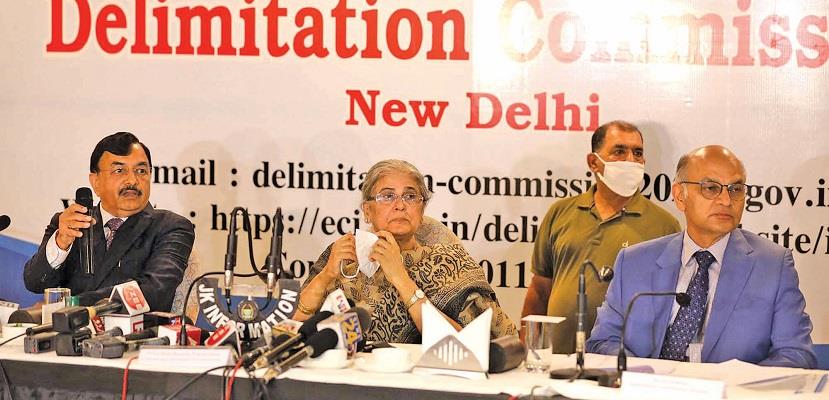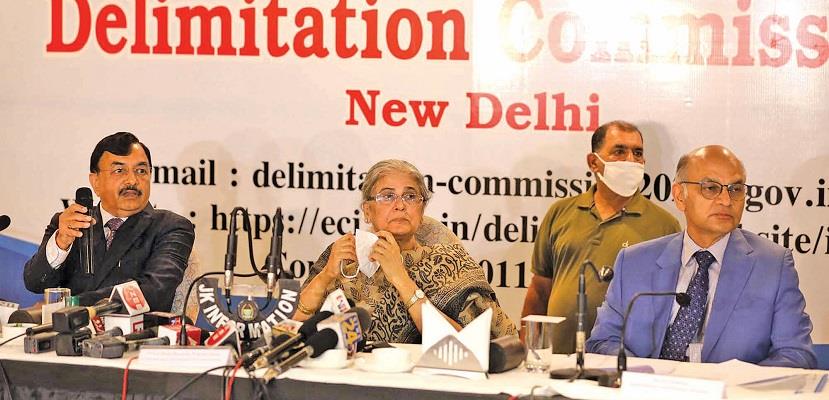Greater Jammu or Greater Kashmir?

Members of the J&K Delimitation Commission at a news conference in Jammu | File Photo
Linking Anantnag with Rajouri and Poonch makes a curious sense: It expands Kashmir into Rajouri and Poonch creating a seamless Muslim belt. And conversely, it extends Jammu into Kashmir
IN October last year, when former senior National Conference leader Devendra Singh Rana suddenly joined the BJP, he made a cryptic remark about the Dickson Plan.
“I pitched for the Jammu Declaration, which will be a voice of Jammu by Jammu for inclusive Jammu and Kashmir. It will defeat the votaries of the Dixon Plan who want to divide the Jammu region on the basis of religion,” Rana said, citing this as a rationale for his decision to switch political parties
The Dickson Plan rings familiar to Kashmiris and anyone interested in Kashmir. The plan proposed by Sir Owen Dixon, a United Nations' representative, in 1953 recommended a solution to Kashmir along religious lines. It proposed assigning Ladakh to India, the northern areas and the Pakistan-Administered Kashmir (PaK) to Pakistan, splitting the Jammu division between the two countries, and recommended a plebiscite in the Kashmir Valley.
The plan, although seen as pragmatic, turned out to be stillborn. It was discussed between India and Pakistan but never made any headway. In recent decades, the plan with some variation was resurrected by the US-based Kashmir Study Group headed by Farooq Kathwari but other than generating some media interest in India and Pakistan, it didn't attract any notice from New Delhi. The KSG plan became known as 'Chenab Formula' according to which Muslim majority areas on the right of the Chenab River would go to Pakistan and the rest to India.
But since the revocation of Article 370 on August 5, 2019, not only have these formulae fallen into oblivion but New Delhi has taken Kashmir off the table with Pakistan.
That is until Rana plucked the Dixon Plan almost out of thin air. And before we could ignore it as part of a politician's perpetual need to seek attention or create a rationale for the new turn in his politics, Delimitation Commission by arbitrarily linking Kashmir's Anantnag with Poonch and Rajouri - two Muslim majority districts in Jammu - has hurtled Rana's stray Dixon Plan remark back into popular discourse.
What is the point of clubbing the areas as far apart as Anantnag in the Kashmir division and Rajouri and Poonch in the Jammu division? Apparently nothing. It has a definite electoral rationale though. But does it have anything to do with some kind of a political settlement of Kashmir along religious lines as indicated by Rana? One has to be first raving mad to believe in this idea.
Would the BJP, which no longer acknowledges its part of Kashmir as a conflict, discreetly and unilaterally seek to divide J&K along religious lines with a nod to some settlement formula for Kashmir? Nothing can be farther from reality.
But there is a plan though. And this is about implementing the BJP's own idea of resolving Kashmir. On July 20, 2019, just a fortnight before the withdrawal of Article 370, Defence Minister Rajnath Singh on his visit to Kargil War Memorial in Drass sector had declared the resolution of Kashmir issue was on the cards and that“no power on the earth can stop it”. At the time, Singh shared no details about this solution But the situation since has made it amply clear what he meant. The BJP is out to execute its own version of Kashmir solution in the teeth of Pakistan and the separatist struggle in Kashmir. And if its actions over the last two and a half years are anything to go by, it seems to have already covered a lot of ground - facing little resistance that the party had otherwise envisaged.
That said, joining Anantnag with Rajouri and Poonch makes a curious sense. As the former J&K minister Haseeb Drabu cryptically indicated in a tweet, it can be interpreted in two ways - it expands Kashmir into Rajouri and Poonch creating a seamless Muslim belt. Or conversely, it extends Jammu into Kashmir, by making a significant area of South Kashmir a part of it.
Now that you have merged Poonch and Rajouri with Anantnag, will the Assembly seats of these districts come to Kashmir Valley, in which case we have 56 seats then? Or alternatively, are you saying that Anantnag is part of Jammu, in which case, they get 57 seats and we get 35?” tweeted Haseeb Drabu, an economist and J&K's former Finance Minister.
So, do we have now Greater Jammu or Greater Kashmir? It plays both ways. A common parliamentary seat spanning Anantnag, and areas of Rajouri and Poonch would also psychologically link the Muslims in these places, no matter the distance. Would the BJP want that? That looks unlikely. Then what is the purpose behind the apparently inexplicable move? Certainly not to bring the Muslim areas of Jammu and Kashmir together.
Perhaps a possible explanation of why the BJP is doing it can be found in an old article written by the BJP's former J&K pointsperson Ram Madhav for a national newspaper titled 'Abrogation of Article 370 was the end of 'Kashmiri exceptionalism.'
“A new generation of leaders not seeped in the glib mindset of exceptionalism is championing these demands,” Madhav wrote in The Indian Express.“Addressing them through early elections to the legislature and restoration of statehood at the appropriate time will strengthen this leadership.”
So, is linking Anantnag with Rajouri and Poonch area, redrawing the constituencies, and even changing their names as a part of diluting the alleged 'Kashmiri exceptionalism.' It could also very well be so.
Views expressed in the article are the author's own and do not necessarily represent the editorial stance of Kashmir Observer

Legal Disclaimer:
MENAFN provides the
information “as is” without warranty of any kind. We do not accept
any responsibility or liability for the accuracy, content, images,
videos, licenses, completeness, legality, or reliability of the information
contained in this article. If you have any complaints or copyright
issues related to this article, kindly contact the provider above.
Most popular stories
Market Research

- Brazil Edtech Market Size, Share, Trends, And Forecast 2025-2033
- Vietnam Vegan Food Market Size, Share, Trends And Report 2025-2033
- Cryptogames Introduces Platform Enhancements Including Affiliate Program Changes
- Accounting And Bookkeeping Service Business Plan 2025: How To Start, Operate, And Grow
- USDT0 And Xaut0 Are Now Live On Polygon
- Global Open Banking Market 20252033: Services, Deployment & Distribution Trends






















Comments
No comment